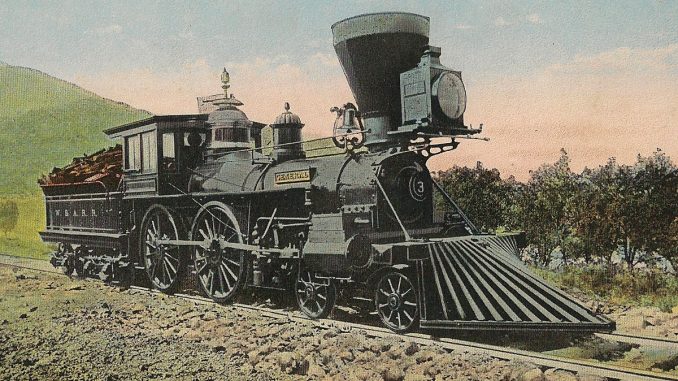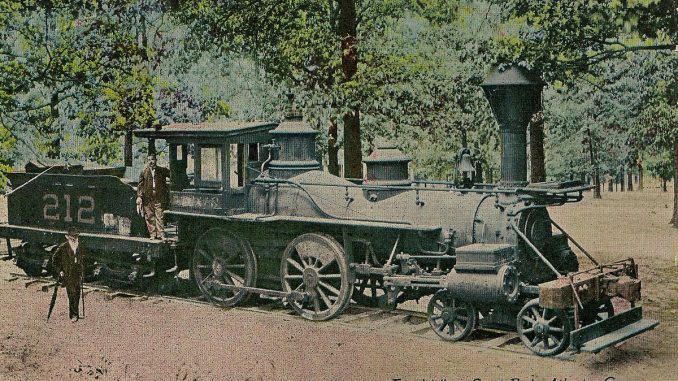
The General
- Builder: Rogers, Ketchum & Grosvenor
- Type: 4-4-0
- Entered Service: January 1856
- Disposition: Displayed in the Southern Museum of Civil War & Locomotive History in Kennesaw, Ga.; previously displayed in Chattanooga, Tenn.
The General was built in 1855 by Rogers, Ketchum & Grosvenor of Patterson, N.J. for a cost of $8,850. In 1864, the locomotive was heavily damaged during Gen. William T. Sherman’s march to Atlanta.
To commemorate the 100th anniversary of the Great Locomotive Chase, the Louisville and Nashville Railroad refurbished the General to working order.
In 1972, the engine was given to the city of Kennesaw, and placed in the Kennesaw Civil War Museum, later renovated and renamed the Southern Museum of Civil War and Locomotive History. Today, the historical engine is the centerpiece of the Southern Museum of Civil War and Locomotive History.

The Texas
- Builder: Danforth, Cooke and Company
- Type: 4-4-0
- Entered Service: October 1856
- Disposition: Displayed at the Atlanta History Center; previously displayed outside at Grant Park and inside the Atlanta Cyclorama
The second-most famous engine of the Great Locomotive Chase. The Texas was built by Danforth, Cooke & Company of Paterson, N.J. in 1856 for a cost of $9,050 and is today on display in Grant Park in Atlanta.
In 1908, the Nashville, Chattanooga & St. Louis donated the locomotive to the city of Atlanta, which placed it on display in Atlanta’s Grant Park. In 1927, the city moved the Texas to the basement of the Cyclorama building.
In 1936, Wilbur Kurtz oversaw several upgrades to the locomotive. In 2014, the city of Atlanta and the Atlanta History Center signed a 75-year agreement to transfer the Battle of Atlanta painting and the Texas to a to-be-built facility at the Atlanta History Center.
The Yonah
- Builder: Rogers, Ketchum & Grosvenor
- Type: 4-4-0
- Entered Service: April 1849
- Disposition: Scrapped circa 1873
Aside from the General and the Texas, the Yonah may be the third most famous locomotive to participate in the Great Locomotive Chase. A yard engine for Cooper Iron Works, the Yonah gave the pursuers their first burst of speed, allowing them to make up valuable time. Conductor William A. Fuller said he made the 14-mile trip from the Etowah River to Kingston in 15 minutes.
William R. Smith
- Builder: Norris Locomotives Works
- Type: 4-4-0
- Entered Service: 1850s
- Disposition: Scrapped
In Kingston, the pursuers boarded the William R. Smith, a Rome Railroad locomotive, in Kingston and headed north. They left the train behind when they reached a section of torn up track. They continued on foot for a while until they ran into the Texas. After its railroad service, the locomotive served as a “stationary engine” in Calhoun, according to a 1962 article by Wilbur Kurtz.
Catoosa
- Builder: Rogers Locomotive and Machine Works
- Type: 4-4-0
- Entered Service: January 1857
- Disposition: Scrapped
Although often overlooked, the Catoosa joined in the pursuit at Calhoun, after a near-wreck with the General. The engine followed The Texas, both operating in reverse.
New York
- Builder: Rogers, Ketchum & Grosvenor
- Type: 4-4-0
- Entered Service: January 1853
- Disposition: Scrapped
After the pursuers arrived in Kingston, Anthony Murphy prepped this locomotive and planned to steam it north out of Kingston. William Fuller, however, had a different plan, and the pursuers ultimately opted for the William R. Smith.
Pennsylvania
- Builder: Norris Brothers
- Type: 4-4-0
- Entered Service: December 1852
- Disposition: Left service by 1868

1 Trackback / Pingback
Comments are closed.